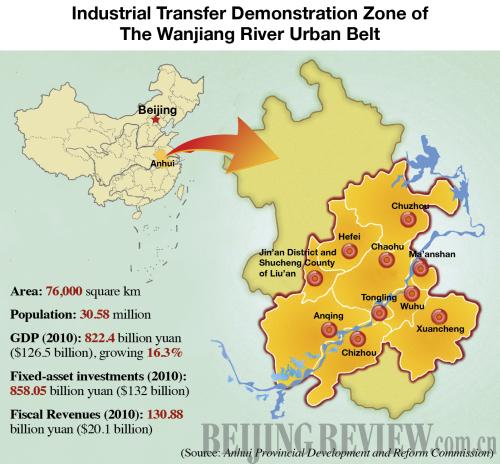|
"The new plant is expected to account for almost half of Hailiang's sales in 2011," he said.
Driving force
The list of Anhui's attractions is long—geographic advantages as a link between east and west China, proximity to natural resources and better transport networks. The Yangtze River facilitates its cargo transport to downstream cities. A high-speed railway came into operation in 2008, shortening travel time between the provincial capital Hefei and Shanghai to barely three hours from eight hours.
The new rail lines will accelerate the "catch-up" that central China is playing with the east, said Ha Jiming, Managing Director of Goldman Sachs Group's investment banking division. "It is creating a virtuous cycle. Relocation of companies creates new job opportunities and that will also encourage an increase in consumption."
Meanwhile, local governments have handed out a string of generous incentives, including favorable land policies, tax waivers and financial support.
Market forces are also putting cities in central China under the spotlight. The south and east coastal areas are losing some ground as land and labor costs creep up. The resource strains and environmental degradation adds urgency to the move away from the coast.
The monthly minimum wage in Anhui is no more than 720 yuan ($110.8), compared with 1,120 yuan ($172.3) in Shanghai. It is estimated that industrial production costs in the province are 30-40 percent lower than in east coastal regions.
An expanding market is also luring investors. With deeper pockets, Anhui's consumers are ready to spend. Retail sales of the province totaled 415.2 billion yuan ($63.9 billion) in 2010, surging 19.2 percent year on year, the third fastest rate across the nation.
Wal-mart, the world's largest retailer, plans to open three more stores in Hefei this year as it makes a push into the burgeoning consumer market. UPS, a global logistics leader, in October 2010 put a new shared-service center into operation in Hefei, its largest in the Asia-Pacific region.
"Delivery demands are burning hot in Anhui where smaller businesses are increasingly merging into the global industrial chain," said Christopher Grubb, Vice President of UPS Asia Pacific Region. "The favorable policy environment here also appealed to us."
The thriving local economy is also luring migrant workers back home. In the past three decades, the province provided millions of migrant workers to factories of the coastal regions. But now the dynamics are changing.
Migrant workers in Anhui totaled around 17 million in 2010, more than 20 percent of whom have returned to work within the province, as more job opportunities are brought to their front doors, said the Department of Human Resources and Social Security of Anhui Province.
Among these workers is 26-year-old Hu Peiman, who in 2007 found his first job in a textile factory in Shenzhen, Guangdong Province. But last year he returned to Anhui and now works on the quality control line of an electronics company in Hefei.
"I now earn a little less than in Shenzhen," said Hu. "But the living costs here, especially house prices, are much lower, and it is also easier for me to take care of my family."
"The labor inflows will also inject fresh steam into other aspects of the local economy like consumption and the services sector," said Lu Zhongyuan, Vice President of the Development Research Center under the State Council. "But it is necessary to strengthen job trainings for returning migrant workers and give support to their job-hunting efforts."
Lu noted that Anhui still has a long way to go to improve its business environment.
"There is growing need to stimulate the logistics industry and provide efficient connections between each link of the industrial supply chain," he said.
Right now, it's estimated that logistics costs in Anhui account for 31.2 percent of its GDP, compared with around 15 percent in the Yangtze River Delta region.
"Meanwhile, efforts are still needed to extend the industrial chain," he said. "Some manufacturing giants are reluctant to move in due to a lack of local parts suppliers."

| 